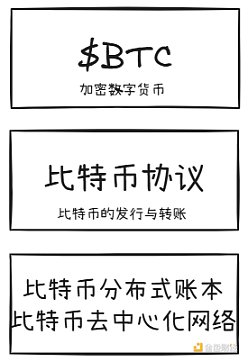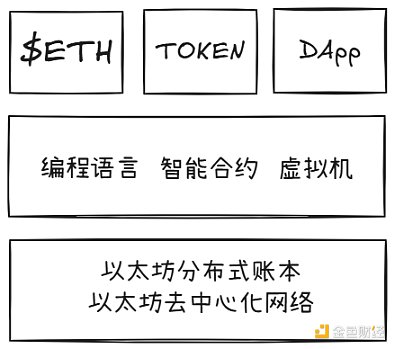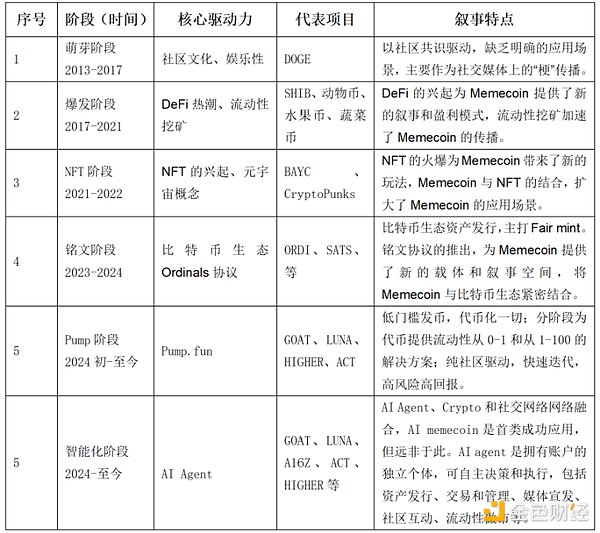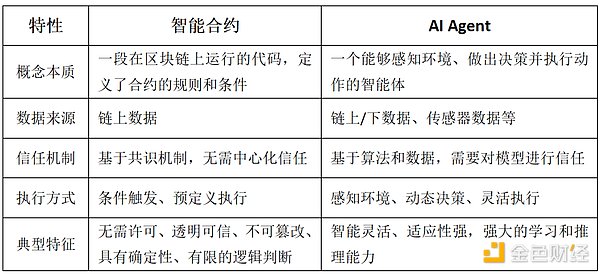Author: Ping Explains Blockchain
"New Infrastructure" refers to the underlying technological elements and architectures with innovative driving forces, such as cryptography, Tokens, distributed ledgers, and smart contracts. These technologies constitute the core pillars of Web3 development. The development process of Web3 is essentially the continuous iteration, integration, and promotion of innovation and transformation of these new infrastructures.
This article will divide the current Web3 development into three stages from the perspective of "core elements", revealing how the core elements in each stage drive the evolution of Web3 through innovation, iteration, and integration.
I. Initial Stage: BTC + Blockchain
The emergence of the Bitcoin blockchain laid the basic structural paradigm for the development of the Web3 industry, as shown in Figure 1-1.

Figure 1-1 shows the three-layer structure of the Bitcoin blockchain system, from which we can extract two core elements:
Encrypted digital currency ($BTC): As a carrier of value, it provides the underlying foundation for value exchange in Web3.
Distributed ledger (Blockchain): As a decentralized trust mechanism and innovative data structure, it provides the possibility for building various decentralized applications.
From the subsequent development, we gradually realize that the structural paradigm and basic elements of the Bitcoin blockchain have had a far-reaching impact on areas such as currency and finance, value exchange and social collaboration, and the development of the Internet, specifically reflected in the following aspects:
Spawned a globalized digital currency: Bitcoin has pioneered the permissionless global circulation of currency, bringing new possibilities to cross-border payments and financial inclusion.
Constructed a decentralized trust mechanism: The public transparency and immutability of the distributed ledger have built a decentralized trust mechanism, promoting efficient value exchange and collaboration globally.
Opened the era of Web3: The success of the blockchain has verified the feasibility of blockchain technology, providing an effective means of carrying and transmitting value, laying the foundation for the development of the Web3 value internet.
As the pioneer of blockchain technology, Bitcoin has brought revolutionary changes and paved the way for the advent of the Web3 era. However, Bitcoin's limited scalability makes it difficult to support complex applications such as smart contracts. In this case, the innovation of Ethereum has driven the industry into the next stage of development.
II. Development Stage: Blockchain + Smart Contract + Token
Ethereum introduced Turing-complete smart contracts on the basis of Bitcoin, making the blockchain not just a digital currency system, but a programmable blockchain platform. The structural paradigm of the Ethereum blockchain is shown in Figure 2-1.

Smart contracts, Tokens, and distributed ledgers play important roles in the structural paradigm of Ethereum:
Distributed ledger (Blockchain): Ensures the security and transparency of data. Builds a diversified public chain ecosystem. Public chains are the foundation of ecosystem development, and their prosperity directly affects the overall development of Web3.
Smart contracts: Smart contracts provide programmability for the blockchain, driving the flourishing development of DeFi. According to the analysis of @0xmiddle, DeFi 1.0 laid the foundation, DeFi 2.0 improved capital efficiency, DeFi 3.0 emphasized composability, and DeFi 4.0 focused on AI intelligence.
Token: Tokens, as carriers of value and incentive mechanisms, provide effective means of value capture for protocols, innovate value distribution methods, and give rise to innovative models such as ICO and DeFi, accelerating industry development.
In summary, the distributed ledger, smart contracts, and Tokens are interdependent and together constitute the infrastructure of the Web3 world in this stage. The innovation of Ethereum organically combines these three elements, generating a powerful synergistic effect, driving the prosperity of the ecosystem and the repeated highs of the industry's total market value, marking a new stage of development for the Web3 industry.
However, after experiencing the initial rapid growth stage, the Web3 industry also faces many challenges, such as the decline in the popularity of VC projects, the failure of the Bitcoin ecosystem to meet expectations, and Ethereum being mired in the FUD dilemma, adding uncertainty to the market.
Currently, the industry has reached a critical turning point and needs new forces to break through the bottleneck and bring innovation and transformation.
III. Acceleration Stage: AI Agent as the New Infrastructure of Web3
At present, we are in the midst of the "Super Memecoin Cycle", with thousands of memecoins emerging. Memecoins, as a type of cryptocurrency originating from Internet culture, have been able to trigger wave after wave of fervor in the cryptocurrency market due to their strong community effects and viral propagation capabilities. But behind each wave of fervor are different core driving factors. As shown in Figure 3-1.

The development history of Memecoins is a microcosm of the cryptocurrency market. Memecoins have always kept pace with the times. In the first five stages of Memecoins, their core driving forces mainly come from within the crypto community and are closely related to Web3 infrastructures such as Blockchain, smart contracts, and Tokens. However, the arrival of the sixth stage marks a new stage of development for Memecoins. AI Agent, as an external force, has successfully broken through the circle and injected new vitality into Memecoins, becoming the new engine for Memecoins.
The addition of AI Agent has brought a qualitative leap to Memecoins:
Narrative Upgrade: AI Agent, through the generation of personalized and high-frequency content, has elevated Memecoins from simple "memes" to digital assets with a deep cultural foundation. For example, the AI-generated religious content of $GOAT not only attracted a large number of users, but also built a unique community culture.
Value Support: AI Agent can monitor market dynamics in real-time and perform data analysis, providing more accurate market strategies for Memecoins. For example, the AI of $LUNA can automatically adjust the token repurchase plan based on market conditions to stabilize the token price.
Community Building: AI Agent can interact with community members in a personalized way, enhancing user stickiness. For example, through natural language processing technology, AI Agent can understand user emotions and provide appropriate responses, enhancing the cohesion of the community.
The addition of AI Agent, with its autonomy, creativity, and social capabilities, has propelled Memecoins to a new level and brought unprecedented development opportunities. However, the potential of AI Agent goes far beyond Memecoins, as it is becoming the new infrastructure of Web3, bringing new transformations to the entire Web3 ecosystem and continuously driving innovation and development in the industry.
IV. Acceleration Stage: AI Agent Becoming the New Infrastructure of Web3
As an intelligent agent capable of autonomous learning, decision-making, and task execution, AI Agent is gradually becoming the new infrastructure of the Web3 world. Its unique position in Web3 stems from its outstanding performance in economic independence, deep integration with smart contracts, and driving Web3 innovation.
1. Economically Independent Digital Entities
In the traditional Internet, AI Agent's functionality is limited due to the lack of legitimate digital identity and asset ownership. However, in Web3, with the help of technologies such as wallets, decentralized identities (DID), and public-private keys, AI Agent can obtain independent digital identities and accounts, be able to own and manage assets, and have the ability to perform verification and signing. In this way, AI Agent becomes an independent economic entity - a digital citizen of the Web3 world. This capability allows AI Agent to actively participate in various financial and economic activities in Web3.
2. The Best Partner of Smart Contracts
Smart contracts and AI Agent, these two seemingly independent concepts, are deeply integrating under the push of Blockchain and artificial intelligence, becoming the best partners for each other.
We will compare the characteristics of smart contracts and AI Agents, as shown in Figure 4-1.

The combination of AI Agents and smart contracts can fully leverage the advantages of both and unleash their potential:
Combining determinism and flexibility: Smart contracts provide a reliable execution environment, while AI Agents can make dynamic adjustments based on real-time data and environmental changes, enabling more flexible applications.
Combining decision-making capability and automated execution: As the intelligent brain, AI Agents can analyze complex problems and make decisions, which can then be automatically executed through smart contracts, improving efficiency.
Integrating on-chain and off-chain data: Smart contracts mainly process on-chain data, while AI Agents can utilize both on-chain data and off-chain data (such as sensor data, social media, and market data) for more comprehensive analysis and decision-making.
Combining decentralization and intelligence: Smart contracts ensure the decentralization and transparency of the system, while AI Agents bring intelligence to the system, helping to realize the vision of decentralized autonomous organizations (DAOs) and decentralized applications (DApps).
Through deep integration with smart contracts, AI Agents will play an increasingly important role in Web3, driving innovation and transformation.
V. AI Agents Usher in a New Era of Intelligent Web3
As a new infrastructure, AI Agents are leading Web3 into a new era of intelligence. This is mainly reflected in the infrastructure and application innovations of various public chains, covering areas such as AI memecoins, systems and tools, AgentFi, AI Payment, games and entertainment, and more, which can be found on the internet.
Among the many public chains, Arweave/AO is highly compatible with the development of AI in terms of architecture and system resources, and the community is highly focused on the development of AI Agents, making it a common goal and action guide to promote the application of AI Agents, which is worth paying attention to.
In terms of system architecture: AO adopts the Actor model in its design, where the core idea is that each component in the system is an independent and autonomous agent capable of parallel computation, which is highly compatible with the application architecture driven by AI Agents.
In terms of system resources: AI relies on three key elements: models, algorithms, and computing power, and therefore has high resource requirements. This is exactly in line with the characteristics of AO's system resources. The Arweave+AO system built on the SCP paradigm has scalable computing, data, and storage resources, which can independently allocate computing resources for each AI process, effectively eliminating computing performance bottlenecks; it can also provide reliable data resources for AI models, helping to reduce model bias during training.
In terms of key technologies: With the support of three key technologies - WASM64, WeaveDrive, and the Llama.cpp large language model inference engine, AO can directly run various large language models, such as Llama 3 and GPT-2, in smart contracts, laying a solid foundation for the development and operation of AI Agent applications.
In terms of basic protocols: The FusionFi Protocol (FFP) is a protocol specification and development tool aimed at connecting different Agents and building information bridges, standardizing the interaction between DApp Agents. Through FFP, various financial services such as trading, lending, and futures can be seamlessly integrated, building a decentralized financial ecosystem across applications and scenarios.
In terms of trusted data: Dria enables AI models to access the latest, complete, and verified information, effectively reducing the biases and inaccuracies common in centralized data sources, thereby providing high-quality data sources for AI Agent applications.
In terms of asset innovation: The initiator of EverVision, @outprog, has innovatively proposed the concept of "AgentFi Tickets", aiming to reconstruct decentralized trust between entities through AgentFi Tickets. This concept allows everyone to exercise sovereignty, issue their own tickets, and manage assets, integrating various financial scenarios such as exchange, futures, collateral lending, and stablecoins.
In terms of application innovation: Permaswap is the leading DEX in the ecosystem, and after launching the FusionFi Protocol, it has integrated multiple financial forms and evolved into a highly liquid super aggregator. Botega, as the first self-agent-driven DEX in the ecosystem, has built an independent process-based AMM system that can autonomously execute advanced order types such as trailing stop-loss, dollar-cost averaging, and limit orders, and intelligently allocate liquidity to improve trading efficiency.
As conditions mature, Arweave/AO, with its advantages in permanent storage of data and atomic assets and super-parallel computing, may unleash the potential of data-driven intelligent business development, meeting the needs of real economic activities on-chain and off-chain.
Although the Arweave/AO ecosystem is still in its early stages, the upstream and downstream sectors are developing in coordination, becoming active builders of the intelligent Web3 era, and the future development prospects are worth looking forward to.
Summary
The development of Web3 is a process of continuous innovation and iteration. Core elements such as distributed ledgers, smart contracts, and Tokens have played a key role in the early and development stages of Web3, driving innovation and maturity in areas such as cryptocurrencies, public chains, and DeFi.
Today, AI Agents, as a new infrastructure for Web3, deeply integrated with other core elements, can play a role in various fields such as Crypto, GameFi, Gaming, Social, and the Metaverse, and will inevitably give rise to new applications and business models. From AI Memecoins to AgentFi, these innovative cases indicate that AI Agents have become the core driving force for the intelligent upgrade of the Web3 ecosystem.
As the public chain ecosystem continues to improve and AI technology continues to progress, AI Agents will play an increasingly important role in Web3, ushering in a more intelligent, open, and inclusive digital new era.






